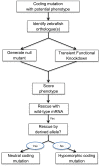Functional assessment of human coding mutations affecting skin pigmentation using zebrafish
- PMID: 23071798
- PMCID: PMC3468441
- DOI: 10.1371/journal.pone.0047398
Functional assessment of human coding mutations affecting skin pigmentation using zebrafish
Abstract
A major challenge in personalized medicine is the lack of a standard way to define the functional significance of the numerous nonsynonymous, single nucleotide coding variants that are present in each human individual. To begin to address this problem, we have used pigmentation as a model polygenic trait, three common human polymorphisms thought to influence pigmentation, and the zebrafish as a model system. The approach is based on the rescue of embryonic zebrafish mutant phenotypes by "humanized" zebrafish orthologous mRNA. Two hypomorphic polymorphisms, L374F in SLC45A2, and A111T in SLC24A5, have been linked to lighter skin color in Europeans. The phenotypic effect of a second coding polymorphism in SLC45A2, E272K, is unclear. None of these polymorphisms had been tested in the context of a model organism. We have confirmed that zebrafish albino fish are mutant in slc45a2; wild-type slc45a2 mRNA rescued the albino mutant phenotype. Introduction of the L374F polymorphism into albino or the A111T polymorphism into slc24a5 (golden) abolished mRNA rescue of the respective mutant phenotypes, consistent with their known contributions to European skin color. In contrast, the E272K polymorphism had no effect on phenotypic rescue. The experimental conclusion that E272K is unlikely to affect pigmentation is consistent with a lack of correlation between this polymorphism and quantitatively measured skin color in 59 East Asian humans. A survey of mutations causing human oculocutaneous albinism yielded 257 missense mutations, 82% of which are theoretically testable in zebrafish. The developed approach may be extended to other model systems and may potentially contribute to our understanding the functional relationships between DNA sequence variation, human biology, and disease.
Conflict of interest statement
Figures






References
Publication types
MeSH terms
Substances
Grants and funding
LinkOut - more resources
Full Text Sources
Molecular Biology Databases

